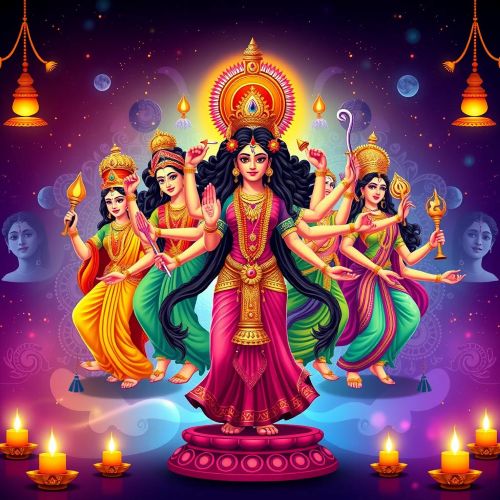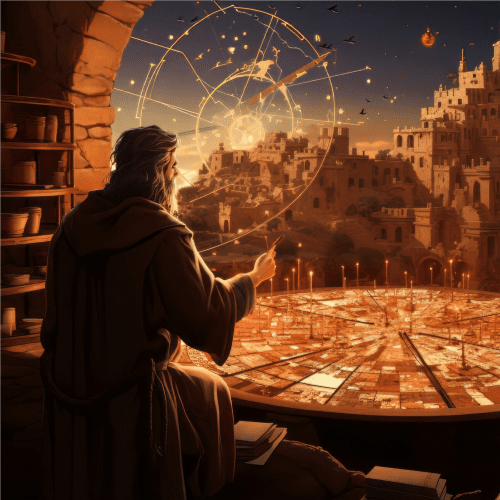Why Do Navratri Colours Change? Fixed and Rotating Traditions Explained
Navratri is one of the most significant Hindu festivals, celebrated over nine nights in honour of Goddess Durga and her nine forms, known as the Navadurga. While the rituals, music, and fasting form the heart of the celebration, the use of colours has become an equally vibrant and symbolic part of the tradition. Each day of Navratri is associated with a specific colour that represents the qualities of the goddess worshipped on that day. Wearing these colours is believed to invite her blessings and align devotees with divine energy. However, if you have ever looked up Navratri colours online, you may have noticed some confusion. Different sources list different sequences, and sometimes even the colours themselves vary. This blog will clear up the mystery by exploring the meaning behind Navratri colours, the two main traditions that determine them, and how they connect with the Navratri goddess.
The Fixed Navadurga Colour System
The most widely accepted system links each day’s colour to the form of the goddess being worshipped. This approach connects directly with the Navadurga and reflects her attributes. In this tradition, the colours remain the same every year:
-
Day 1 – Yellow (Shailaputri): Yellow represents joy, brightness, and new beginnings, perfectly symbolising Shailaputri, the daughter of the Himalayas and the starting point of the spiritual journey.
-
Day 2 – Green (Brahmacharini): Green signifies growth, peace, and harmony, reflecting the goddess of penance and discipline.
-
Day 3 – Grey (Chandraghanta): Grey combines calm with strength, fitting for Chandraghanta, who balances serenity and courage.
-
Day 4 – Orange (Kushmanda): Orange radiates energy, creativity, and enthusiasm, linked to Kushmanda, the cosmic creator.
-
Day 5 – White (Skandamata): White symbolises purity and peace, qualities embodied by Skandamata, the nurturing mother of Kartikeya.
-
Day 6 – Red (Katyayani): Red represents passion, strength, and righteousness, suiting Katyayani, the fierce warrior goddess.
-
Day 7 – Royal Blue (Kalaratri): Royal Blue stands for power and protection, reflecting Kalaratri’s fierce yet benevolent form.
-
Day 8 – Pink (Mahagauri): Pink symbolises compassion, love, and hope, aligning with Mahagauri, the serene goddess of forgiveness.
-
Day 9 – Purple (Siddhidatri): Purple conveys ambition, wisdom, and spiritual fulfilment, connected to Siddhidatri, the bestower of supernatural powers.
This system is especially popular in North India and among those who follow the devotional symbolism of each goddess form.
The Rotating Colour System (Maharashtra & Gujarat)
In western India, especially in Maharashtra and Gujarat, Navratri is as much a social and cultural festival as it is a religious one. The evenings are filled with Garba and Dandiya dances, and people take great pride in dressing up in the colour of the day. Unlike the fixed Navadurga colour system, here the colours are not permanently assigned to each goddess. Instead, they rotate every year based on the weekday on which the festival begins.
This practice comes from the Hindu Panchang (calendar), where each weekday is ruled by a planet or deity. For instance:
- Monday – Ruled by Lord Shiva and the Moon → White or Light Colours (peace, purity, calmness)
- Tuesday – Ruled by Hanuman and Mars → Red (strength, courage, energy)
- Wednesday – Ruled by Mercury → Green (harmony, balance, growth)
- Thursday – Ruled by Lord Vishnu and Jupiter → Yellow (wisdom, prosperity, positivity)
- Friday – Ruled by Goddess Durga or Venus → Pink (compassion, love, beauty)
- Saturday – Ruled by Shani (Saturn) → Blue (discipline, depth, protection)
- Sunday – Ruled by the Sun → Orange (vitality, enthusiasm, energy)
When Navratri begins, the colour of the first day is determined by the weekday deity, and then the following days follow a pre-set sequence. As a result, the colours change from year to year, making every Navratri slightly unique. For devotees, this adds excitement and a sense of freshness, because even if you’ve celebrated for decades, each festival feels new.
Fashion designers, jewellers, and retailers in these regions often launch special Navratri collections around the yearly colour list, and it’s common to see Garba venues filled with coordinated groups dressed in the shade of the day. For young devotees, this rotating colour system turns Navratri into a blend of devotion and celebration, where spirituality meets self-expression.
Why Do the Navratri Colours Differ?
The conflicting lists you see online are not mistakes; they are reflections of these two traditions. The fixed Navadurga colour system is spiritual and symbolic, while the rotating system is cultural and calendar-based. Both are valid, and which one you follow depends on your region, family practice, or personal preference. In fact, some people combine the two: following the goddess symbolism while also checking the yearly list.
The Spiritual Meaning of Wearing Colours
The idea of Navratri colours is not only about outer appearance — it’s deeply spiritual. In Hindu philosophy, colours are seen as vibrations of energy that affect both the body and the mind. Each colour resonates with a specific quality or guna, and by wearing that colour, devotees are believed to align themselves with the energy of the Navratri goddess worshipped on that day.
For example:
-
Yellow (Day 1) attracts optimism, positivity, and clarity. It helps devotees begin their nine-day journey with enthusiasm and light-heartedness.
-
Green (Day 2) promotes balance and renewal, guiding the worshipper to inner peace during the worship of Brahmacharini.
-
Grey (Day 3) may seem dull at first, but spiritually it symbolises the ability to remain calm in adversity and to draw strength from neutrality.
-
Orange (Day 4) is the colour of vitality, energy, and transformation — perfect for Kushmanda, who created the universe.
-
White (Day 5) purifies the mind and soul, encouraging devotees to let go of negativity while worshipping Skandamata.
-
Red (Day 6) ignites passion and courage, preparing the mind to face challenges like the warrior goddess Katyayani.
-
Royal Blue (Day 7) brings depth, stability, and divine energy, aligning with the fierce yet protective Kalaratri.
-
Pink (Day 8) spreads compassion, hope, and unconditional love, reflecting Mahagauri’s serene forgiveness.
-
Purple (Day 9) symbolises ambition, mysticism, and spiritual awakening, matching Siddhidatri’s power to bestow siddhis.
When devotees wear these colours, they are not just participating in a tradition; they are consciously attuning themselves to the energy of the goddess. The simple act of wearing a shade becomes a daily meditation, a reminder to cultivate the virtues of that form of Durga.
On a collective level, colours also create a sense of unity and harmony. In a sea of yellow-clad devotees on Day 1 or red-clad Garba dancers on Day 6, the shared expression of devotion builds community spirit. Colours act as visual prayers — silent yet powerful — that connect millions of people across regions and traditions during Navratri.
The Modern Appeal of Navratri Colours
In recent years, Navratri colours have become more than just a devotional practice. They have entered fashion, lifestyle, and popular culture:
-
Social Media Trends: Every Navratri, hashtags around “Day 1 colour” or “Navratri OOTD” (Outfit of the Day) trend on Instagram and Twitter.
-
Corporate Celebrations: Many offices in India organise themed dress codes for employees based on the Navratri colours, creating unity and festive spirit.
-
Shopping and Fashion: Clothing brands and online stores promote collections around the Navratri colours, making it easy for devotees to participate.
This blending of tradition and modernity has kept the practice alive and exciting for younger generations.
Which Navratri Colours Should You Follow?
If you feel confused, the answer is simple: follow the system that resonates with you. If you connect deeply with the symbolic qualities of each goddess, the fixed Navadurga colours are perfect. If you love the idea of annual variations and the community spirit in states like Maharashtra and Gujarat, the rotating system works just as well. Ultimately, the essence of Navratri lies in devotion, not just in what colour you wear. The colours are a joyful way of expressing faith and unity, but the true celebration is in honoring the Navratri goddess with sincerity.
Conclusion
Navratri colours are more than just fashion choices; they are spiritual symbols that align devotees with the energy of the Navratri goddess. While some traditions fix the colours based on the Navadurga, others rotate them depending on the lunar calendar. Both carry meaning and beauty, and both reflect the diversity of Hindu culture. Whether you dress in yellow for Shailaputri, red for Katyayani, or purple for Siddhidatri, what truly matters is the devotion behind the celebration. This Navratri, embrace the colours with joy, knowing that each shade tells a story of courage, purity, peace, and divine power.
No posts were found.









